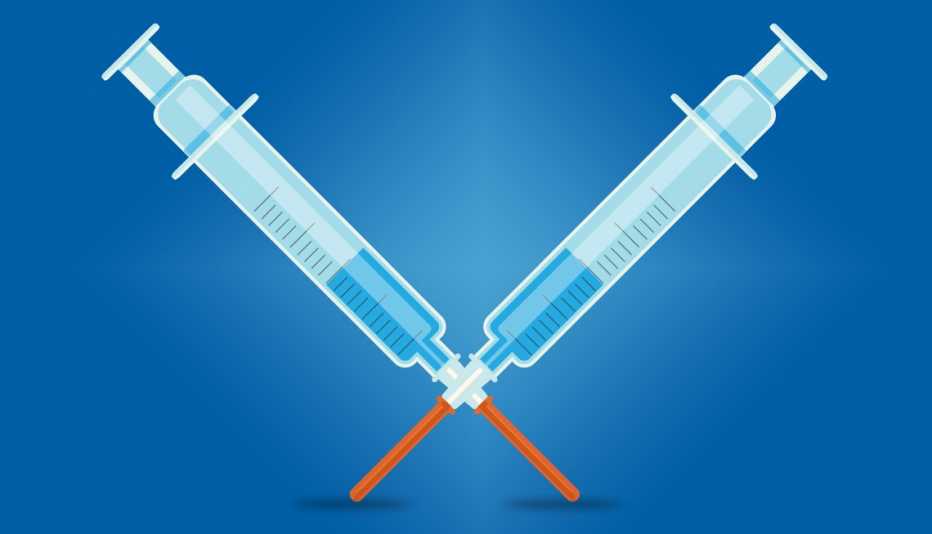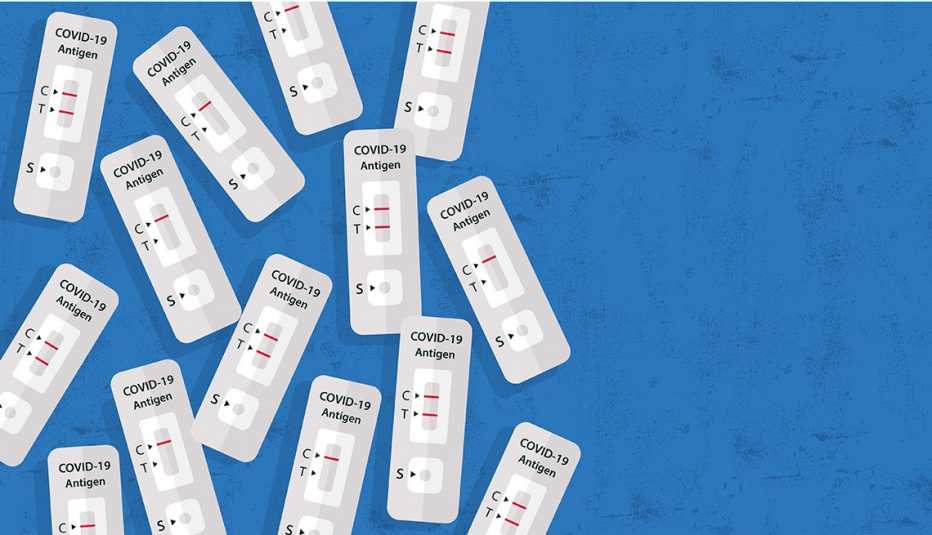Staying Fit
As the pandemic enters its fifth year, staying informed about the latest developments with the disease, including new variants and treatments, remains especially important for older adults, who are most at risk for severe illness and death from COVID-19.
Here’s a summary of recent coronavirus news that’s particularly relevant to people 50 and older, followed by answers to some of the most frequently asked questions about COVID-19.
Latest COVID-19 news
FDA authorizes new drug for immunocompromised individuals (March 26). The Food and Drug Administration (FDA) has authorized a new medication that can help protect immunocompromised people from serious symptoms of COVID-19. The drug — a monoclonal antibody infusion, called Pemgarda — is expected to be available in the coming weeks. Unlike other COVID treatments, the medication is meant to be used ahead of an infection (called pre-exposure prophylaxis) as another layer of protection for people who are unlikely to mount an adequate immune response to the vaccines.
CDC updates COVID isolation guidelines (March 1). Health officials at the Centers for Disease Control and Prevention (CDC) have updated isolations guidelines for people with COVID-19. The new recommendations suggest staying away from others when you’re sick and returning to normal activities when, for at least 24 hours, symptoms are improving and you're fever-free without the use of a fever-reducing medication. At that point, wearing a mask and practicing other preventive steps is still encouraged for at least five days.
Adults 65-plus should get a spring COVID-19 vaccine (Feb. 29). The CDC is recommending that adults 65 and older roll up their sleeves this spring for another dose of the COVID-19 vaccine. More than half of COVID-19 hospitalizations during October 2023 to December 2023 occurred in this age group, and deaths continue to remain highest among older adults. “An additional vaccine dose can provide added protection that may have decreased over time for those at highest risk,” CDC Director Mandy Cohen, M.D., said in a statement.
Novavax’s updated vaccine gets green light from FDA (Oct. 4). The Food and Drug Administration authorized Novavax’s updated COVID-19 vaccine on Oct. 3 for people 12 and older. Similar to the revised vaccines from Pfizer-BioNTech and Moderna, Novavax’s protein-based vaccine targets XBB.1.5, a more recent version of the coronavirus. The company said in a news release that the new shot will be available in thousands of locations across the U.S.
New COVID-19 vaccines get the green light (Sept. 12). A new batch of COVID-19 vaccines that are a closer match to the coronavirus variants that are currently circulating throughout the U.S. have been approved and recommended by health officials, and are now available in pharmacies and doctors’ offices across the country. The shots, from Moderna and Pfizer-BioNTech, target the XBB.1.5 strain of omicron. While this particular variant is no longer driving the majority of the country’s infections, its relatives are, and experts say the vaccines should provide good protection against them. It’s recommended that individuals 6 months and older get the new vaccine. Uninsured and underinsured individuals will be able to receive the vaccines for free under the CDC’s new bridge access program.
How can you catch COVID-19?
COVID-19 is the name of the disease caused by a coronavirus called SARS-CoV-2. You can catch COVID-19 by breathing in air if you are close to an infected person who is exhaling small droplets and particles that contain the virus. You can get it if those small droplets and particles land in your eyes, nose or mouth (likely through coughs or sneezes) or if you have virus particles on your hands and touch your eyes, nose or mouth.
Who is at risk for COVID-19?
Anyone can get COVID-19, but some people are more at risk for what experts call “severe disease” that may require hospitalization or intensive care.
Older adults are more likely than younger, healthier people to experience serious illness from COVID-19. The vast majority of COVID-19 deaths in the U.S. have occurred among people 50 or older — and the risk increases with age.
Adults of any age with an underlying medical condition are at increased risk for complications from a coronavirus infection. Among the factors:
- Cancer
- Chronic kidney disease
- Chronic lung diseases, including COPD (chronic obstructive pulmonary disease), asthma (moderate to severe), interstitial lung disease, cystic fibrosis and pulmonary hypertension
- Dementia or other neurological conditions
- Diabetes (type 1 or type 2)
- Down syndrome
- Heart conditions (such as heart failure, coronary artery disease, cardiomyopathies or hypertension)
- HIV infection
- Immunocompromised state (weakened immune system)
- Liver disease
- Mental health conditions, including depression and schizophrenia spectrum disorders
- Overweight and obesity (defined as a body mass index of 25 or greater)
- Pregnancy
- Sickle cell disease or thalassemia
- Smoking (current or former)
- Solid organ or blood stem cell transplant (includes bone marrow transplants)
- Stroke or cerebrovascular disease, which affects blood flow to the brain
- Substance use disorders (such as alcohol, opioid or cocaine use disorder)
- Tuberculosis
What can you do to reduce your risk?
There are a number of ways you can reduce your risk of getting sick from COVID-19. Chief among them: get vaccinated. The FDA has officially approved two vaccines — from Pfizer-BioNTech and Moderna — and both have been updated to target more recent versions of the virus.
The FDA has issued an emergency-use authorization (EUA) for an updated COVID-19 vaccine developed by Novavax for people 12 and older.
All three vaccines are effective at preventing hospitalization and death from COVID-19, and health officials are encouraging everyone 6 months and older to get vaccinated.
A few other ways to lower the likelihood of getting sick from COVID-19: Wear a high-quality face mask when you’re in public indoor settings, avoid crowds and poorly ventilated spaces, and wash your hands often.
Do the vaccines have side effects?
It’s common to experience mild to moderate side effects after getting vaccinated, such as soreness in the arm, headache, fatigue, muscle and joint pain, nausea, fever or chills — but these are temporary “and normal signs that your body is building protection,” the CDC says.
A small number of vaccine recipients have experienced adverse reactions to the shots. These serious events after COVID-19 vaccination “are rare but may occur,” the CDC says. Anaphylaxis, an allergic reaction, has occurred in a small share of the vaccinated population — approximately five cases per 1 million doses administered. This is why you may be asked to wait about 15 minutes after your shot or booster to monitor for symptoms. Vaccine providers are equipped with medicines to quickly treat the reaction.
Health officials are monitoring reports of myocarditis or pericarditis in some adolescents and younger adults after vaccination with the Pfizer, Moderna and Novavax vaccines. Most of these patients who received care responded well to medicine and felt better quickly, the CDC says. It’s also monitoring rare reports of Guillain-Barre syndrome, which was more commonly associated with the Johnson & Johnson COVID-19 vaccine, which is no longer available.
Can you get COVID-19 even if you’re fully vaccinated?
No vaccine is 100 percent effective, so while the COVID-19 vaccines can lower your risk of getting a coronavirus infection, it’s still possible to get COVID-19 — this is known as a breakthrough infection. People with breakthrough infections, however, are less likely to get severely sick or die from COVID, multiple research studies show.
What are the symptoms of COVID-19?
People with COVID-19 have reported a wide range of symptoms that typically appear two to 14 days after exposure to the virus, including:
- Fever or chills
- Cough
- Shortness of breath or difficulty breathing
- Fatigue
- Muscle or body aches
- Headache
- Loss of taste or smell
- Sore throat
- Congestion or runny nose
- Nausea or vomiting
- Diarrhea
This list is not exhaustive, and more unusual symptoms have been noted throughout the pandemic — from cognitive complications to skin rashes.
Most people with COVID-19 can recover at home. However, if you develop emergency warning signs — pain or pressure in the chest; disorientation or confusion; pale, gray or blue-colored skin, lips or nail beds; difficulty breathing; or an inability to wake or stay awake — get medical attention immediately.







































































